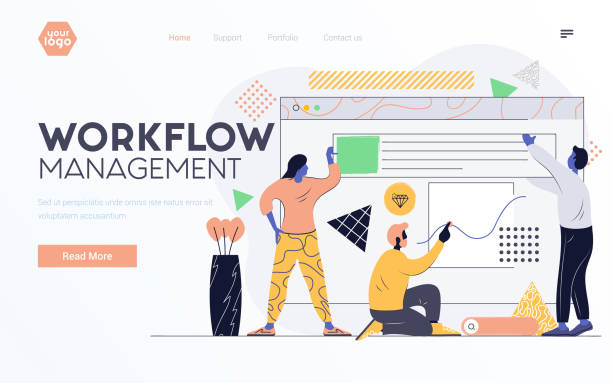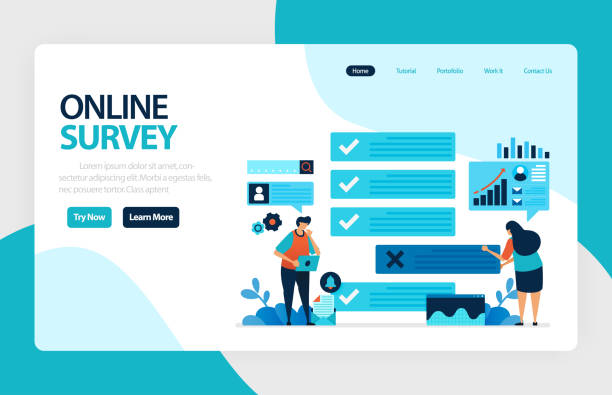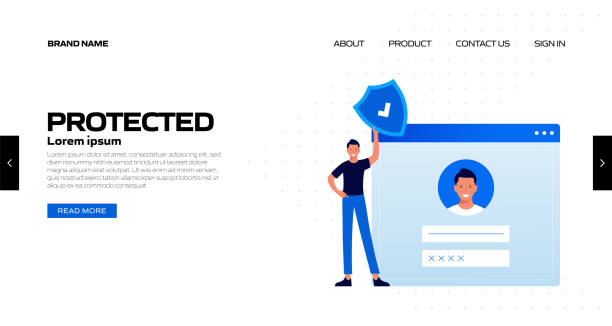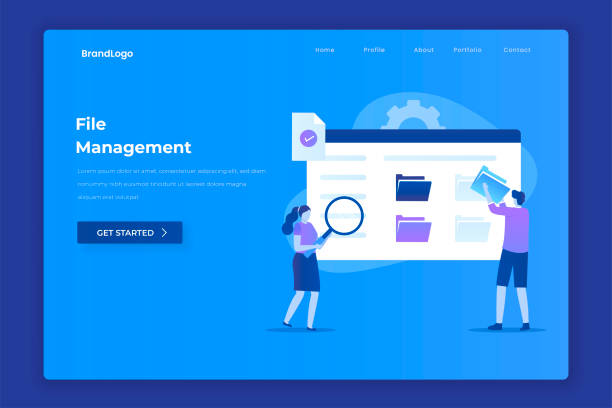Introduction and Fundamental Importance of Responsive Website Design in the Digital Age

In today’s world, where internet access occurs through various devices such as mobile phones, tablets, laptops, and even smart TVs, the concept of responsive website design (Responsive Web Design) has become an undeniable necessity.
#Web #Design #Responsive It is no longer possible to design a website for a specific screen size and expect to provide a consistent user experience for all users.
This analytical approach demonstrates how websites must adapt to different screen dimensions to present content in the best possible way, hence its importance grows daily.
The main goal of responsive website design is that regardless of the device type, screen size, or orientation (horizontal or vertical), the website is optimally displayed so that the user does not need to zoom in, zoom out, or scroll horizontally.
This explanatory approach states that this not only significantly improves user experience (UX) but also has a direct impact on website SEO (Search Engine Optimization).
Search engines like Google rank websites that are optimized for mobile higher in search results, and this is important news for any business looking to be seen in the online space.
These fundamental changes in Google’s ranking algorithms highlight the need for a deep understanding of modern web design standards.
From a technological perspective, responsive design is built upon three main pillars: Fluid Grids, Flexible Images, and Media Queries in CSS3.
These components work together to allow the website to dynamically adjust its layout based on the user’s device characteristics.
As educational content, understanding these fundamental principles is crucial for any web designer or developer planning to enter the modern web domain.
How a website can intelligently switch between different layouts has always been a puzzling topic for non-technical users, and this technical complexity requires specialized knowledge.
Today, almost all successful and highly visited websites follow the principles of responsive website design.
This is not just an option, but an industry standard recommended by global web professionals.
Ignoring this standard means losing a large portion of potential audiences, as statistics show that a significant part of internet traffic comes from mobile devices.
This increasing trend has further highlighted the need for responsive websites.
Therefore, if you are looking for success in the digital space, optimizing your website for responsiveness is the first step and a key guideline that should be taken seriously.
This specialized approach considers not only current needs but also the future growth trend of the web, ensuring the sustainability and effectiveness of your website.
Don’t have a corporate website yet and missing out on online opportunities? With professional corporate website design by Rasavab,
✅ Double your business credibility
✅ Attract new customers
⚡ Free consultation for your corporate website!
Fundamental Principles and Key Technologies in Responsive Website Design

To deeply understand responsive website design, it is essential to delve into its fundamental principles and underlying technologies.
This section, in a specialized and educational manner, helps you understand the mechanisms behind a responsive website.
The first and perhaps most important principle is the use of Media Queries in CSS3.
This capability allows developers to apply different styles for devices with specific characteristics (such as screen width, height, orientation, and resolution).
Using this technique, the appearance and layout of a website can be easily changed based on the display size.
This flexibility is the backbone of any responsive design.
The second key principle is Fluid Grids.
Instead of using fixed pixel widths, responsive design utilizes relative units like percentages.
This means that the width of page elements is displayed based on their proportion to the overall screen width, rather than absolute values.
This explanatory approach ensures that the page layout automatically adapts to any screen size.
For example, if a column occupies 20% of the page width, it will occupy more space on a larger screen than on a smaller one, but it will always maintain 20% of the total width.
This feature significantly helps in creating a smooth user experience without the need for horizontal scrolling.
The third pillar is Flexible Images.
Images and multimedia content can often disrupt the layout on smaller devices.
To solve this problem, images should be coded in such a way that their width, like fluid grids, adjusts relative to their parent element.
Typically, the max-width: 100%; CSS property is used, which ensures the image never exceeds its container and automatically scales down to fit the available space.
This is a practical and very important guideline for maintaining the visual appeal and performance of a website across different devices.
This specialized approach not only prevents clutter but also helps improve page loading speed.
Beyond these three principles, other modern technologies and approaches such as Flexbox and CSS Grid Layout also play an increasing role in simplifying the implementation of responsive design.
These methods give developers more power to control the layout and alignment of elements on web pages and facilitate the process of building adaptive websites.
Understanding these principles and technologies is the cornerstone of any successful endeavor in responsive web design and creating superior user experiences across all devices.
This specialized knowledge allows you to address the challenges of modern web design with greater confidence.
Countless Benefits of Responsive Website Design for Users and Businesses

Implementing responsive website design is not just a trend, but a strategic investment that brings significant benefits to end-users as well as businesses.
This section analytically and explanatorily examines these benefits.
The first and most important advantage is the significant improvement in user experience (UX).
When a website is displayed flawlessly on any device, users will not have the frustrating experience of needing to zoom or scroll horizontally.
This leads to increased user satisfaction, reduced bounce rate, and increased time spent by users on the site.
This is one of the most vital factors for the success of any website.
The second major advantage is the positive impact on Search Engine Optimization (SEO).
Google and other search engines prefer websites that offer a good mobile experience.
By having a responsive website, you have only one URL, which makes SEO management much easier, unlike having separate mobile and desktop versions.
This approach helps prevent duplicate content and centralizes domain authority in one place.
In fact, Google officially announced in 2015 that responsiveness is an important ranking factor, and this is crucial news for every webmaster.
Economically, responsive design leads to cost reduction.
Instead of developing and maintaining multiple separate versions of a website (one for desktop, one for mobile, etc.), only a single website needs updates and maintenance.
This not only reduces initial development costs but also significantly lowers future costs related to support and updates.
This is an important financial guideline for small and large businesses looking to optimize their budget.
It also means easier content management and brand consistency across all platforms.
| Feature | Responsive Website Design | Separate Mobile/Desktop Versions |
|---|---|---|
| Number of URLs | 1 (SEO improvement) | 2 or more (SEO complexity) |
| Development and Maintenance Cost | Lower | Higher |
| User Experience | Optimal across all devices | May vary |
| Future Compatibility | High | Low |
| Content Management | Integrated and easy | More complex |
Furthermore, responsive websites provide flexibility and future-readiness.
With the continuous emergence of new devices with diverse screen sizes, a responsive website automatically adapts to these changes, without the need for costly redesigns.
This feature ensures the long-term sustainability of your website and guarantees victory in the digital competition.
Finally, an increased conversion rate is another significant advantage; because users with a more comfortable and fluid experience will be more inclined to take desired actions (such as purchasing, registering, or contacting).
This is a thought-provoking piece of content as to why some businesses have not yet moved in this direction.
Common Challenges and Solutions in Implementing Responsive Website Design

Despite numerous benefits, implementing responsive website design is not without challenges.
This section, as a specialized guide, addresses some of these common obstacles and practical solutions to overcome them.
One of the biggest challenges is managing content and images across different screen sizes.
High-quality images suitable for desktop might be heavy on mobile devices, slowing down loading speed.
The solution to this problem is to use responsive image techniques such as srcset and sizes in HTML5, or to use a CDN (Content Delivery Network) to deliver optimized image sizes based on the user’s device.
Another challenge relates to website performance on mobile devices.
Even if the layout is responsive, if the CSS and JavaScript code are too large or unoptimized, the site will still be slow.
To resolve this, code optimization (minification and concatenation), asynchronous loading of scripts, and font optimization are essential.
Additionally, using the Mobile-First technique in design and development, meaning designing for the smallest screen first and then moving towards larger ones, can significantly help improve performance.
This is a crucial guideline for any developer.
Testing and debugging across different environments is another complexity.
Ensuring that the website displays correctly across all browsers and devices (with various screen sizes) requires extensive testing tools.
Browser simulators (like Chrome developer tools), real device testing tools, and automated testing frameworks can be helpful in this regard.
This specialized process requires patience and precision to ensure a flawless user experience.
The thought-provoking content here is how to implement a comprehensive and efficient testing process within a limited budget.
Finally, content strategy is also important for responsive design.
Content designed for a large screen might lose its readability on a small screen.
Therefore, content design should be done considering information prioritization and the removal of unnecessary elements for smaller devices.
This includes using simpler navigation, clear CTAs (Call to Actions), and concise, useful text.
An analytical approach to content helps ensure that each part of it is purposeful and effective.
By considering these challenges and implementing the suggested solutions, the successful implementation of a responsive website can be ensured.
Does your current e-commerce website design lead to losing customers and sales?
Rasavab is your solution with modern and user-friendly e-commerce website designs!
✅ Significant increase in conversion rates and sales
✅ Strong branding and building customer trust
⚡ Get a free e-commerce website design consultation from Rasavab!
Leading Tools and Frameworks in Responsive Website Design

To facilitate the implementation process of responsive website design, several tools and frameworks are available to developers, each with its own features and advantages.
This section, as an educational guide, introduces some of the most popular and efficient of these tools.
Bootstrap is undoubtedly one of the most well-known and widely used CSS frameworks.
Using its 12-column grid system, ready-to-use UI components, and JavaScript plugins, Bootstrap enables developers to quickly build fully responsive websites with minimal coding.
This framework is suitable for projects of any size.
Foundation is another popular and powerful framework for responsive design, developed by ZURB.
Foundation is known for its high flexibility and focus on Mobile-First development.
This framework provides tools not only for websites but also for building responsive emails and complex web applications.
If you are looking for a framework with high customization capabilities and suitable performance, Foundation is an excellent choice.
This is a useful guide for selecting the right tool based on your project needs.
In addition to comprehensive frameworks, native CSS techniques such as Flexbox and CSS Grid Layout also play a vital role in building responsive layouts.
Flexbox is very powerful for one-dimensional layouts (rows or columns) and distributing space between items, while CSS Grid Layout is ideal for two-dimensional layouts (rows and columns) and creating more complex, grid-based designs.
These two native technologies provide more precise control over element placement without the need for heavy frameworks and are widely used by developers today.
This specialized knowledge is essential for anyone who wants complete control over their project.
Other helpful tools include Preprocessors like Sass and Less, which by adding features such as variables, functions, and Mixins to CSS, make coding more organized and efficient and help create responsive CSS code.
Additionally, online responsiveness testing tools and various device simulators in browsers help designers and developers examine and optimize their websites in different environments.
The choice of the right tool depends on the project’s complexity, the development team’s priorities, and your website’s specific needs.
Using these tools makes the process of building a responsive website much faster and more efficient.
The Future of Responsive Website Design and Emerging Trends

In the ever-changing world of the web, responsive website design is also evolving, and emerging trends are taking shape that will influence the future of the web.
This section, in a news and analytical format, examines these trends and provides a glimpse of what lies ahead.
One of the most important of these trends is the expansion of Progressive Web Apps (PWAs).
PWAs are a combination of the best features of web and native applications, providing a fast, reliable, and engaging user experience and are also capable of working offline.
This technology elevates the responsiveness experience from merely aesthetic to functional.
Another trend is Accelerated Mobile Pages (AMP).
Although AMP has been somewhat controversial, its goal is to deliver content faster on mobile devices.
AMP loads web pages in fractions of a second through intensive optimizations in HTML, CSS, and JavaScript.
This is important news for content publishers and news sites for whom loading speed is critically important and directly impacts user experience and SEO ranking.
Implementing AMP, alongside a responsive design, can significantly increase content access speed.
A greater focus on performance and optimizing web page loading speed will continue to be one of the main priorities in the future of responsive design.
Users expect websites to load quickly and without delay, especially on mobile devices with unstable internet connections.
Using techniques such as Lazy Loading for images, compressing codes and resources, and optimizing fonts will become increasingly important.
This is a specialized guideline that every web designer should pay attention to, to ensure a smooth user experience.
The emergence of new technologies such as Artificial Intelligence (AI) and Voice User Interfaces will also impact the future of web design.
Websites must be designed to be compatible with these technologies and provide a seamless user experience.
This could include designing for voice search or even dynamic layouts that change based on user behavior and AI.
These trends create thought-provoking content regarding how current designs can adapt to a future that is not yet fully defined.
In summary, the future of responsive web design is moving towards greater intelligence, higher speed, and fully personalized user experiences.
The Impact of Responsive Website Design on SEO and Digital Marketing Strategies
![]()
One of the most significant reasons that has made responsive website design a necessity is its direct and profound impact on Search Engine Optimization (SEO) and overall digital marketing strategies.
This section specialized and analytically examines this connection.
Google, as the largest search engine, officially announced in 2015 that it prefers mobile-friendly websites in its search results.
This means that if your website is not responsive, it will likely have a lower ranking in mobile searches, which constitutes a large portion of web traffic.
The most important SEO advantage of responsive design is having a single URL for all devices.
This prevents the creation of duplicate content, which can harm the site’s SEO ranking.
It also simplifies the management of backlinks and Domain Authority, as all SEO signals are directed to a single URL.
This explanatory approach helps search engines to more effectively crawl and index your website, which ultimately leads to improved visibility of your website in search results.
This is good news for any business looking to increase organic traffic.
Furthermore, the improvement in user experience (UX) achieved through responsive design indirectly impacts SEO.
Factors such as low bounce rate, longer user time on site, and higher engagement are all positive signals for search engines, indicating the high quality and relevance of your content.
Google considers these behavioral factors in its ranking algorithms.
Therefore, a responsive website not only directly improves SEO ranking but also indirectly helps it by creating a better user experience.
| SEO Factor | Impact of Responsive Design | Description |
|---|---|---|
| Mobile-Friendliness | Positive and Crucial | Google’s algorithms prefer mobile-friendly websites. |
| Duplicate Content | Reduction or Elimination | A single URL prevents content duplication. |
| Page Load Speed | Potential for Improvement | Loading speed increases with resource optimization. |
| User Experience (UX) Signals | Indirect Improvement | Reduced bounce rate, increased time on site, and user engagement. |
| Backlink Management | Simplification | All backlinks are directed to a single URL. |
Finally, reduced SEO and marketing costs is also a significant advantage.
Instead of investing in two separate SEO campaigns for mobile and desktop versions, you can focus all your efforts and resources on one comprehensive strategy.
This is a practical guide to optimizing your digital marketing budget.
Additionally, the ability to provide a consistent user experience across all devices contributes to Omnichannel Marketing strategies and effectively conveys your brand message wherever the user is present.
This analytical approach demonstrates how a technical decision can transform business outcomes.
User Experience (UX) and User Interface (UI) Considerations in Responsive Website Design

Responsive website design goes beyond merely adjusting element sizes for different displays; it involves deeper considerations in user experience (UX) and user interface (UI) to ensure that users have an enjoyable and effective interaction with the website on any device.
This section delves into these considerations in a specialized and explanatory manner.
One of the key principles is Mobile-First design.
This approach means starting the design for the smallest screen and then expanding it towards desktop.
This ensures that from the outset, the focus is on essential content and core functionality, preventing unnecessary additions and elements that could be distracting on mobile.
Navigation also holds special importance in responsive design.
On small devices, screen space is limited, so navigation menus must be designed to be compact yet accessible.
Using patterns like the “Hamburger Menu” or Tabbed Navigation is common.
Additionally, the size and spacing of buttons and links should be large enough to be easily tappable with a finger (Finger-Friendly Design) to prevent user errors.
This is a crucial guideline for every UI designer.
Content readability and typography are also important factors in responsive UX.
Font sizes, line heights, and color contrasts must be adjusted to maintain optimal readability on any screen size.
For example, smaller fonts might be unreadable on mobile, while very large fonts occupy too much space on desktop.
Using relative units like em or rem for font sizing can help maintain proportion across different devices.
This analytical approach helps in choosing the best solution for text presentation.
Finally, visual feedback and interactions must be considered.
Animations, hover effects, and other visual interactions might be appealing on desktop but may not be functional or could even disrupt the user experience on mobile.
The design must ensure that interactive elements are clearly identifiable and provide appropriate feedback to the user, regardless of how they interact (mouse click or finger touch).
This specialized approach adds not only to the aesthetics but also to the usability of the website, and it’s thought-provoking how user experience can be maximized across all devices.
By observing these considerations, a responsive website can be created that is not only beautiful but also completely user-friendly.
Does your current website turn visitors into customers or drive them away? With professional corporate website design by Rasavab, solve this problem forever!
✅ Create strong credibility and branding
✅ Attract target customers and increase sales
⚡ Get a free consultation now!
Successful Examples and Case Studies of Responsive Website Design

To better understand the power and efficiency of this web design approach, a look at successful examples and real-world case studies can be very illuminating.
This section funnily and explanatorily delves into some of these examples, showing how large and small brands have used this approach to improve user experience and achieve their business goals.
One of the most classic examples is The New York Times website.
This site was one of the first pioneers in adopting responsive design, defining a new standard for news websites by providing a unified and optimized layout across desktop, tablet, and mobile.
This approach enabled easy access to content for millions of readers worldwide.
Another example is Airbnb’s website, which, with its responsive design, has simplified and unified the accommodation booking experience for users on any device.
From searching for locations to viewing details and making reservations, everything is designed to be easily accomplishable whether on a large laptop screen or a small mobile screen.
This has directly contributed to increasing Airbnb’s conversion rates and customer satisfaction.
This case is a good analytical study in the field of online businesses that allows users to access their services anytime, anywhere.
In the e-commerce sector, Zara’s website is also a prominent example of successful responsive design implementation.
This international apparel brand has optimized the online shopping experience across all devices by focusing on large images and clear product displays.
Users can easily browse products, view details, and complete their purchases without needing to zoom or scroll excessively.
This improvement in user experience has directly led to increased sales and customer loyalty.
This is a guide for any online retailer on how to achieve higher sales.
Even smaller sites and local businesses can benefit from responsive web design.
For example, a local restaurant with a responsive website can ensure that potential customers can easily find its menu, operating hours, and location via their mobile phones.
This not only helps increase reservations and visits but also presents a professional and up-to-date image of the business.
These cases raise questions as to why some businesses have not yet grasped the importance of this approach.
These examples demonstrate that responsive design is not only for tech giants but is a fundamental step toward success in the digital space for any type of business of any size.
Best Practices and Advanced Tips for Mastering Responsive Website Design

Mastering responsive website design is not just about knowing the basics, but also about adhering to best practices and employing advanced tips to provide an unparalleled experience for users across all devices.
This section, as a guide and educational resource, covers the most important of these tips.
The first and perhaps most crucial tip is Mobile-First thinking throughout all stages of design and development.
Instead of designing for desktop and then trying to condense it for mobile, first design for the smallest screen, and then gradually add features and details for larger screens.
This approach ensures your site performs optimally on mobile and prevents unnecessary extra work.
The second tip is Performance Optimization.
Even an excellent responsive design will result in a poor user experience if it loads slowly.
Using techniques such as Image Compression, Lazy Loading for below-the-fold content, and minimizing HTTP requests can significantly improve loading speed.
Furthermore, using performance measurement tools like Google Lighthouse is very useful for identifying weaknesses and improving them.
This is a specialized guideline that should not be overlooked.
Attention to Touch-Friendly Design is another crucial tip.
On touch devices, pointer accuracy is less than a mouse, so buttons and links should be large enough and spaced appropriately to prevent touch errors.
The minimum recommended size for touch elements is 48×48 pixels.
Additionally, the use of Hover States, which do not exist on mobile, should be designed to have suitable touch alternatives.
These considerations help increase user interaction and reduce frustration.
Finally, continuous and comprehensive testing on real devices and various simulators is essential.
The smart device market is rapidly changing, and you must ensure that your website displays correctly across different types of devices and browsers.
Using CSS frameworks like Bootstrap or Foundation can simplify the design process, but meticulous testing is still required.
This analytical approach ensures your site always performs optimally.
By implementing these best practices, you can build a responsive website that meets not only current but also future user needs and becomes a valuable asset for your business.
Frequently Asked Questions
| Question | Answer |
|---|---|
| What is Responsive Web Design? | It is an approach that ensures your website’s layout displays well on any device (such as mobile, tablet, and desktop) and adapts to the user’s screen size. |
| Why is responsive design important? | Improved user experience across different devices, increased traffic and conversion rates, improved search engine ranking (SEO), and reduced need for developing separate mobile versions. |
| How is responsive design implemented? | By using CSS media queries to apply different styles based on device characteristics (like screen width), and by using fluid grids and flexible images. |
| What are the main technologies used in responsive design? | HTML5, CSS3 (especially Media Queries), and JavaScript. |
| What are the main advantages of responsive design? | Consistent user experience across different devices, easier website maintenance, better SEO (as Google prefers responsive sites), and cost/time savings compared to developing a mobile application or separate site. |
And other services of Rasavab Advertising Agency in the field of advertising:
Smart Direct Marketing: A combination of creativity and technology for customer acquisition through SEO-driven content strategy.
Smart Marketing Automation: A creative platform for improving customer acquisition with custom programming.
Smart Customer Journey Mapping: An effective tool for improving SEO ranking with the help of an SEO-driven content strategy.
Smart UI/UX: A fast and efficient solution for improving SEO ranking with a focus on marketing automation.
Smart Customer Journey Mapping: A professional solution for increasing website traffic with a focus on an SEO-driven content strategy.
And over a hundred other services in the field of internet advertising, advertising consulting, and organizational solutions.
Internet Advertising | Advertising Strategy | Advertorial
Resources
- What is Responsive Web Design?
- The Evolution of Responsive Web Design
- Responsive Website Design Tutorial
- What is Responsive Website Design?
? With Rasavab Afarin, build your business’s future in the digital world. By providing innovative digital marketing solutions, from personal and corporate website design to SEO and targeted advertising, we help you keep your brand at its peak. With us, have a powerful and influential presence in the online space.
📍 Tehran, Mirdamad Street, next to Bank Markazi, Kazerun Jonubi Alley, Ramin Alley, No. 6




